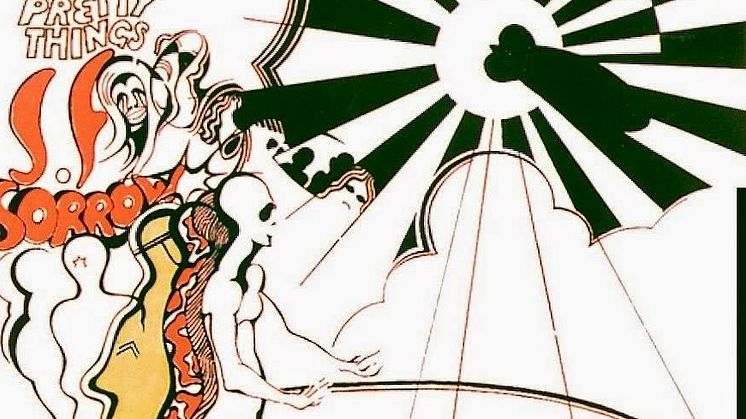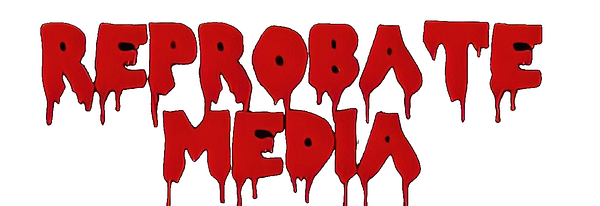
Blog post -
SPANISH STROLL #1: A Look Back At SF Sorrow with The Pretty Things
Locked inside. Endless distractions circle in vain attempts to block out the reality outside. The ten records that shaped you. Your life history in a list (ripe for the hackers). The most embarrassing photo of your youth. You compete with the latest interactive tour of the Louvre as you countdown the wait to the next Cirque Du Soleil performance. Even in our isolation, our attention is bombarded. However, one question from a friend has sparked a reassessment of all this. As we flick from one app to another, surely we should be able to use this time to apply the brakes on our consumption, not only monetary but also in our attention. Are we able to shut out the constant call of the digital world to sit down and focus our attention in only one place, one book, one record, one person at our side?
The question my friend posed was simple.
What record should I put on and listen to from start to finish with not a single other distraction?
I had two ideas for him. The first was the sprawling double album of Manassas by the Stephen Stills-fronted supergroup, but the second trumps that. Possibly the first true and complete narrative concept album: SF Sorrow by The Pretty Things
A couple of years back I caught up with Phil May and Dick Taylor from the band to talk to them about the album and its recording. Here's the article in full (originally published on Louder Than War)
The Pretty Things look back at SF Sorrow
As the British invasion sound of the early 60s grew and developed into an insatiable beast, the founding bands themselves looked to stretch their wings, douse their music in psychedelia and create records that were more than simply a collection of songs. The idea of the story concept album was born and in 1968 one band took the idea to its fruition, creating what can be argued to be the first true narrative concept album.
The Beatles had taken a stab at the concept album with Sgt. Pepper, but as masterful as the record was, the idea only managed to last the first two songs, and Lennon himself disowned the idea that his contributions had ever been envisaged as part of the concept. The Small Faces had come out with Odgen’s Nut Gone Flake, but only the second half of that record followed a single narrative. It’s true also that there had been numerous albums with overarching themes over the preceding decades (Woody Guthrie’s Dust Bowl Ballads, Sinatra’s In The Wee Small Hours, Zappa’s Freak Out), but no artist had ever before created such a bold piece of work that took one story and told it through a collection of wonderful, twisting, swirling and, at times, intensely dark songs. On S.F. Sorrow, The Pretty Things unleashed their psychedelic masterpiece, and threw down the gauntlet to their contemporaries, challenging them to really step up. And step up some of them certainly did as the album went on to influence other soon to be more well-known ‘rock operas’.
S.F. Sorrow followed their previous album, Emotions, a record that the band admitted to being embarrassing. For singer Phil May the situation was clear. “I think the album was hi-jacked. So we had a choice, we either stood our ground and fought the company to seize back control or cut out losses and run.” Emotions was overdubbed with orchestral arrangements that saw it taken far from where they had originally envisaged and despite possessing a quality of song writing and melody that should have seen them garnering multitudes of new fans, the band refused to play much of it live. But that’s not to say that the process didn’t have some silver lining, as Phil continues, “One of the few positives about Emotions was we realised we needed to get into creating our own material, ie. writing. Also Wally Waller and Jon Povey’s arrival provided us with another colour in our pallete. Our new direction was already taking shape. We were already moving on. And there was no love loss between us and Fontana.” Free from their contract with Fontana, the band signed to EMI. Money was not the aim, but artistic freedom was.
Emotions, however, was also to be a precursor to what was to follow for them artistically, as lead guitarist Dick Taylor says: “Without Emotions there would have been no S.F. Sorrow. It was Wally and Jon’s introduction to recording with Phil and I. The harmony blend started there, it was kind of a semi concept album, and despite the heavy-handedness of most of the additional instrumental arrangements (with the exception of the Sun), it kind of got us thinking of breaking away from the guitar, bass and drum format. I have a snaking fondness for it.”
Phil has previously stated that they did not want to go back and write another typical record so, inspired more by classical music and opera, they embarked on the idea to create a musical journey, a means of commanding their own destiny and releasing themselves from the treadmill they were on. With the idea of creating one 40 minute tale based on a short story he had written entitled Cutting Up Sergeant Time about the life of a soldier in the First World War trenches, the band developed a twisted tale from birth to death. Phil explains, “I think this is partly a “lost in translation” moment. The short story that S F Sorrow was based on was originally called Sargeant Sorrow. But I demoted him so that I could extend his story both forwards and backwards, in youth and in age, to provide a wider context.”
And extend it they certainly did. The story arc takes the listener on a literary journey of the band’s protagonist, Sebastian F. Sorrow, told through the songs themselves and the entwined paragraphs in the liner notes that accompanied the original album. From birth to death; through the drudgery of monotonous work that saps S.F.’s creativity and sees him labelled as a scab; his sexual awakening; the draw of love and lust; war; the death of his fiance; reflection on his life through a spiritual journey with the mysterious Baron Saturday; and finally a drifting into mental anguish and a depression and seclusion that leads him eventually to his death. The band holed up in Abbey Road Studios at the tail-end of 1967 and set to work.
In the studio, the band, chemically-enhanced, had no problem spending days and nights pushing their studio time, and technicians, to the max. Early synthesisers were built; tracks bounced from machine to machine creating sometimes hundreds of layered tracks that formed the complex and schizodelic sound, one credited in part to the dedicated work of sound engineer Peter Mew, for whom S.F. Sorrow was his first full studio album. A baptism of fire, no doubt, it certainly must have been. Following an album that they didn’t want to play, The Pretty Things eventually emerged with a record near-impossible to actually recreate live, even for the band themselves. In fact, it wasn’t until 30 years later that the band pulled it off. Returning to the Abbey Road studio where it was originally recorded and, with the help of Dave Gilmore on lead guitar and Arthur Brown narrating, they produced S.F. Sorrow Resurrection.
Of course, in the studio, immersed in their own world, the recreation of the album was not on their minds. As Dick recalls: “I don’t think we gave a thought to playing it live, we were so absorbed in making the album. Having Norman Smith as our producer enabled us to give free rein to our imaginations, and his own of course. To have worried about how we would play it would have put a limit on what we could do and we weren’t into limits at the time. (By 1998) we were doing more and more of it in our live set. I think it was our manager – Mark St John, who first suggested doing it live. Despite some initial misgivings that we could do it justice we started rehearsing it and the whole thing blossomed. I think it was one of the things which sparked off more interest in the album.” Phil continues, “The time was right to put the whole thing back in the spotlight. So with Snapper (our record label) onboard it quickly developed into a live world webcast (the first, globally, I believe) and a DVD with the special guests. So – S F Sorrow was resurrected.”
Not only was S.F. Sorrow innovative and ground-breaking in its subject and sonics, but it was also a masterclass in the use of music to create mood, each song perfectly encapsulating its lyrical theme and the feelings of its protagonist. Album opener S.F. Sorrow Is Born chimes with optimism in its acoustic guitars and the following songs dealing with the innocence of his youth continue to float along on a more psychedelic folk wave, but when disasters strike and things turn sour, such as on Balloon Burning, the music takes on a dark intensity rarely seen before. It’s almost Krautrock before its time, the repeating two guitar notes creating a woozy effect over the pulsing rhythm. The introduction of Baron Saturday sees the band kicking up a tight percussion focused march, before Sebastian is taken on a floatingly trippy flight on The Journey. The sign off of Loneliest Person is an aching twinkle, a lonesome goodbye from our protagonist.
Like any great work of art, it’s one that has also been the subject of continued analysis. Where does Sebastian die in the tale? At the end, as would be supposed? Or does he actually die in war on the fourth track, Private Sorrow (which finishes with an alphabetical reeling off of war deaths that fades out just before his name would be read), and is what follows almost a Jacob’s Ladder journey with the Haitian Voodoo priest guiding him to accept his fate and make his way to the underworld? If so, it’s a fate that he rejects, and thus condemns himself to hell. Dick throws water on the idea though. “Sorry, Sebastian didn’t end up hobnobbing with Paul McCartney minus his shoes, not unless Phil knows something different and just hasn’t told me yet.”
“I’m unaware of the Jacobs ladder theory,” says Phil, “But I always believe the listeners right to interpret the lyrics and narrative as they feel it, it’s a subjective process.” Either way, it’s not the most uplifting of stories and its dark subject matter, coupled with a lack of promotion from the studio led to low sales. However, it is a dark tragic odyssey to rival the great classics and one that not only influenced future concept albums, but also the sound of modern bands such as Kasabian. It was the band’s unrelenting drive to create a piece of art as opposed to a commercial endevour that resulted in a slow-burning fire that has had a sustained impact. Dick reflects, “Despite the somewhat disappointing sales when it was first released I always regarded it as an artistic success. It is great that so many people now regard it as an important milestone and an inspiration (thank you Serge). It’s actually quite extraordinary that it commands so much respect. What more could we want.” For Phil, the blow seemed to hit harder. “It was a kick in the balls and for my part, if I hadn’t been deep into the ribs of the process of writing material for the next album – “Parachute” – the blow could have been terminal. I like to think that it proves that real class will eventually get the recognition it deserves.”
Although it was misunderstood at its time of release, especially in America where it was released after The Who’s Tommy and unjustly referred to by Lester Bangs as an inferior copy of Townsend’s rock opera, it has stood the test of time with grace and in today’s world of one-song downloads provides not a morsel, but a feast for the listener to consume in its entirety. 50 years on S.F. Sorrow should be held up as one of the greatest pieces of art of its time – the first fully-realised narrative concept album.
------------------------------------------------------------------------------------------
Nathan Whittle is a writer based in Santander Spain since 2009. He currently writes for Louder Than War in the UK and Ruta 66 in Spain.

